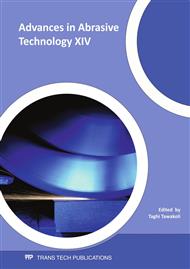p.699
p.707
p.713
p.719
p.725
p.731
p.739
p.745
p.751
Effect of Microshot Peening on Residual Stress of High-Toughness Spring Steel
Abstract:
In general, shot peening is a surface treatment that improves the performance of engineering components, since application of surface compressive stresses reduces the tensile component of stress. In the shot peening process, the medium consists of small spheres, which are usually made of high-carbon cast steel; the diameter of the spheres is in the range from 0.3 to 1.2 mm. More recently, a new type of microshot has been developed to enhance the peening effect. The diameter of the new spheres is in the range from 0.02 to 0.15 mm. The effect of microshot peening on the residual stress of spring steel was investigated. The projective method of the microshot was of the compressed air type. The microshot of 0.1 mm diameter was high-carbon cast steel and cemented carbide, and the workpiece used was the commercially spring steel JIS-SUP10. The effect that process variables such as shot speed and peening time have primarily on residual stress was studied. The surface layer of the workpieces was sufficiently deformed by microshot peening. The residual stress was observed near the surface. At a large number of cycles to fracture, microshot peening can more effectively enhance the fatigue strength. The use of hard microshots such as cemented carbide was found to cause a significantly enhanced peening effect for spring steel.
Info:
Periodical:
Pages:
745-750
Citation:
Online since:
August 2011
Authors:
Price:
Сopyright:
© 2011 Trans Tech Publications Ltd. All Rights Reserved
Share:
Citation:


